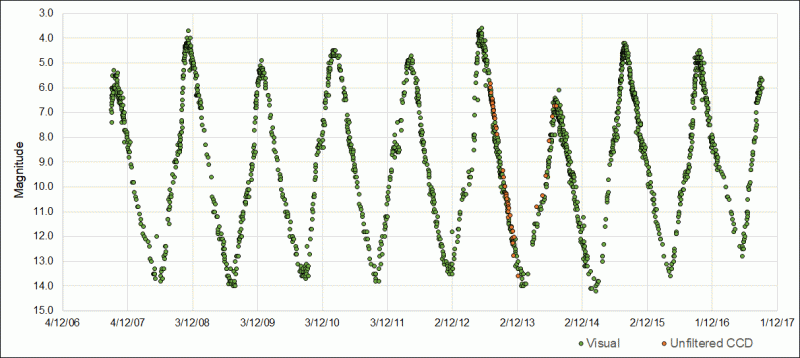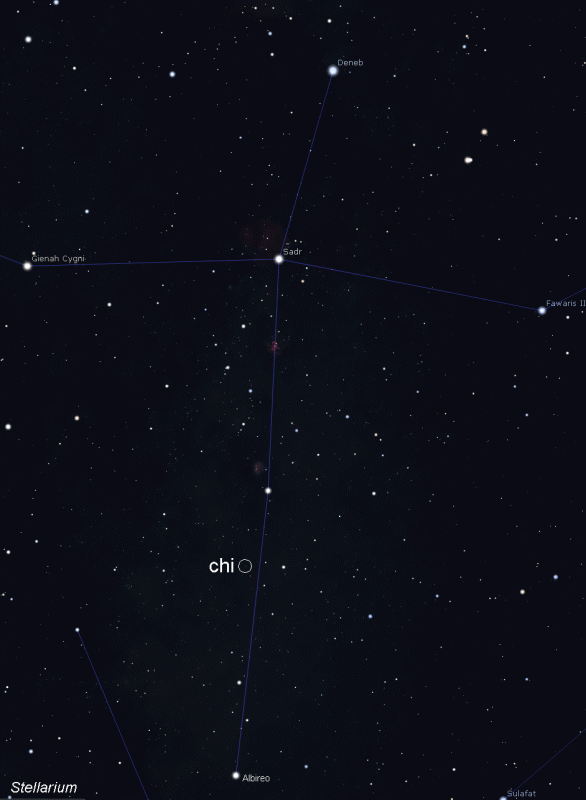2017 September 21
chi Cygni makes an appearance
Over the next few weeks, keen eyed observers might note a star emerging into naked eye visibility in the constellation Cygnus. chi Cygni, a Mira type variable star will be reaching maximum brightness during October. It will be an easy binocular object, a possible naked eye star and an ideal target for DLSR imaging.
Lying at a distance of some 550 light years, chi Cygni is a red giant AGB star of spectral type S6,2e – S10,4e. The change in luminosity occurs with a change in the physical size of the star itself, with a variation of some 350 to 500 solar diameters through its cycle. Mira type variable stars (which used to be called Long Period Variables or LPVs) are at their brightest state when the star is at its smallest diameter. As the star increases in size the luminosity and temperature decreases, which can affect the dust concentration around the star. At minimum brightness TiO lines are prominent in the spectrum, and the H-alpha emission line varies across the pulsation cycle making Mira type stars popular with spectroscopists with modest equipment. Amateur observations of Mira stars are extremely important in helping us to understand the complexities of stellar pulsation, and as these types of stars have been observed continually since the 19th century, they give us a wonderful insight on how pulsating stars behave over a long time-period. chi Cygni has been observed by members of the BAA Variable Star Section since 1840.

The mean period for chi Cygni is 408 days – from one minimum to the next, and the rise to maximum brightness is about 9% shorter than the decline to minimum. The amplitude (the range of brightness) can vary too, from ~8 magnitudes to ~11 magnitudes, and chi Cyg has the distinction of having the largest range in brightness of any known variable star, not counting transient objects such as Novae and Supernovae.
The period of 408 days is pretty stable, but the levels reached at maximum and minimum magnitude are impossible to predict. The official range is 5.2-13.4, but this year’s maximum follows the second brightest minimum on record, which was observed in May of this year at 12.8 visual. What will chi Cyg do next? The brightest minimum in the BAAVSS database occurred in 1962, when chi Cyg only faded to 12.5 visual, and was followed by a maximum slightly brighter than 5th magnitude. As I write these words (September 14) chi Cyg is already at visual magnitude 5.6 and we have technically another month to go before maximum, but it’s always a dangerous game to predict what a variable star will do. The light curve is currently indicating that the rise has slowed and is possibly levelling out with a mean magnitude of 5.6. Does this mean an early broad faintish maximum, or is this just a pre-maximum glitch and the star will slowly continue to rise over the next month or so? We have no way of knowing, which means observations this season are more valuable than ever!

Minimum brightness can reach 14.5 so there can be a two magnitude variation at these lower levels, and maximum brightness is just as unpredictable. 2013 saw a very bright maximum of 3.8 mean, followed by one of the faintest maxima on record with a mean magnitude of 6.7 in 2014 – a three magnitude variation at peak brightness! There is enough uncertainty in these maximum and minimum values to keep us all interested from one season to the next!
Observing chi Cyg in the coming weeks should prove interesting and a lot of fun. Look for it with the naked eye, binoculars or set your DSLR by locating the 4th magnitude star eta Cygni in the middle of the ‘swans neck’, then look about 2.5 degrees (five Moon diameters) on a line to beta Cyg (Albireo) in the head of the Swan. You will see chi Cyg as the reddest star in the vicinity. Depending on your light pollution you might need to use small binoculars to see it at the moment, but hopefully as we move into October, chi Cyg will may well pop into naked eye view if the star behaves itself. You don’t have to make estimates of its brightness to monitor the changes in its magnitude of course, as these will be very evident if you observe it once a week or so (anything more frequent might introduce bias), but if you do fancy having a go at accurately estimating it’s magnitude, the BAAVSS charts contain comparison stars for chi Cyg, and we have some useful tips for absolute beginners on how to make an estimate.
If you do make estimates, please don’t forget to report them to the Variable Star Section, as we will be very happy to receive them. Once maximum brightness has been reached chi Cyg will slowly fade to minimum (which is expected in 2018 July), but will remain visible in binoculars for several months over the Autumn/Winter period.
Whether you make accurate magnitude estimates or not is unimportant, simply go outside to watch and enjoy this wonderful red giant star brighten and fade over the coming months, and marvel at the physics which is enabling us to witness such an event with our unaided eye or the minimum of optical aid!
Good luck
Gary Poyner
| The British Astronomical Association supports amateur astronomers around the UK and the rest of the world. Find out more about the BAA or join us. |
